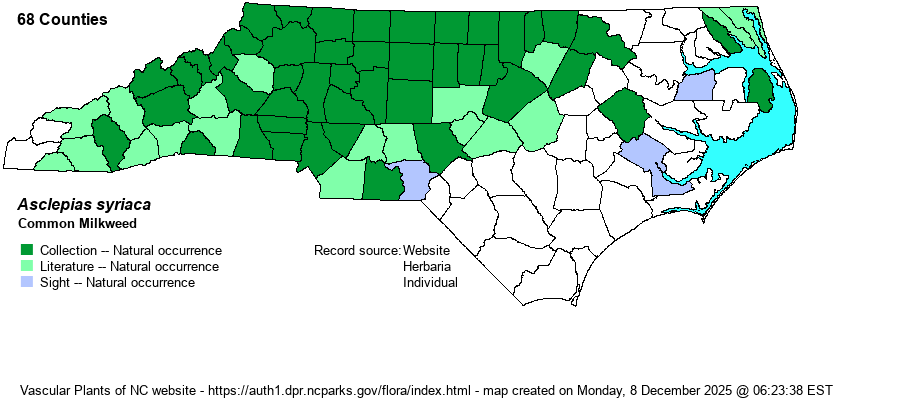| Author | L. | |
| Distribution | Essentially throughout the Piedmont (but scarce in the far southeastern counties); present over the northern and central Mountains, but sparingly in the southwestern counties. Found only at a few scattered places in the northern half of the Coastal Plain. However, the species seems to be expanding its range southward, and may well occur over nearly all of the Mountains and Piedmont by now. To date, absent from the Sandhills proper, but occurs in the nearby Piedmont.
This is a Northern species that ranges south to central NC, northern GA, and OK. Over its large range, it is found in nearly every county, indicating an abundant species.
| |
| Abundance | Increasing in recent decades. Formerly considered "Infrequent" in the Piedmont (Blomquist and Oosting 1959), but now generally common in the Piedmont and the northern 2/3rds of the Mountains. Rare in the southwestern Mountains and southeastern Piedmont. Very rare in the northern Coastal Plain, known south to Washington and Craven counties, but likely to increase or spread in upcoming decades. Weakley (2018) says "This species is apparently expanding its range southward", with which the website editors agree. | |
| Habitat | This is a species of full to partial sun, in old fields, weedy pastures, roadbanks, woodland borders, and other brushy places. It is usually found in mesic conditions, not in wetlands nor in overly dry or sandy soils. |
| Phenology | Blooms from late May into August, and fruits from July to September. | |
| Identification | This is a quite robust milkweed, with a thick stem that often grows to 5 feet tall, rarely to 6 feet or more. It is unbranched, and the numerous pairs of opposite leaves are quite large, being elliptical, about 6-7 inches long and about 3 inches wide. The leaves are quite thick and white/tomentose below. The top portion of the plant is heavily laden with 2-6 dense flower clusters (umbels) that contain "uncountable" numbers of flowers in a baseball-sized "globe" about 2-3 inches across. The flowers are mostly rose-pink in color, and the umbels seem so heavy that they often droop to the side. The species occasionally hybridizes with Poke Milkweed (A. exaltata). On a rare occasion, the species could be confused with the scarce A. purpurascens, but that species has a shorter stem, normally grows in damp places, and in bloom has deeper rose-purple flowers. Common Milkweed is an old-field colonist in many parts of the state, and where found usually occurs in very dense stands of several square meters, to the exclusion of most other species. The flowers are heavily used for nectar by a great diversity of insects, and as a result, butterfliers are usually drawn to stands of blooming Common Milkweed. | |
| Taxonomic Comments | None. The scientific name means "Syrian", though Fernald (1950) states "early carried from e. Am. to s. Eu. and supposed by Linnaeus to have come from the Orient". As this is a species of old fields and other brushy places, it has been occasionally suggested whether this species is native at all to North America, though apparently it is not known to be native outside of North America.
| |
| Other Common Name(s) | Essentially no others in frequent usage. Rarely used are Butterfly-flower, Silkweed, Silky Swallow-wort, and Virginia Silkweed. | |
| State Rank | S5 | |
| Global Rank | G5 | |
| State Status | | |
| US Status | | |
| USACE-agcp | UPL link |
| USACE-emp | FACU link |

